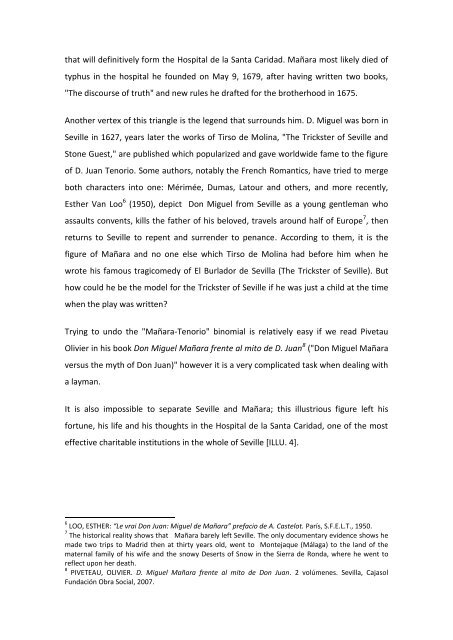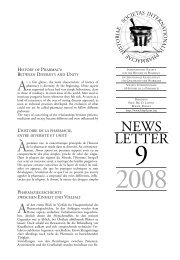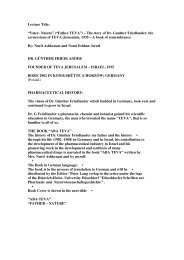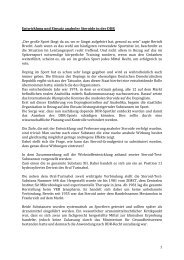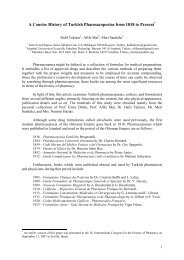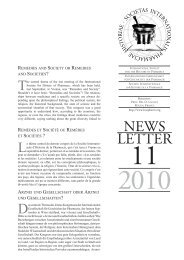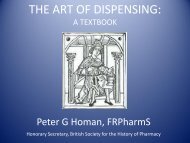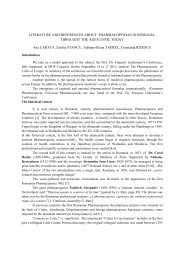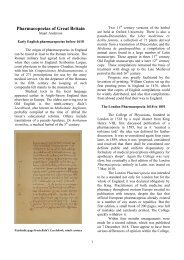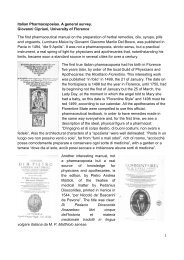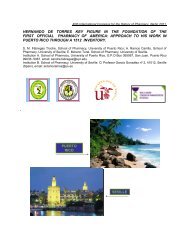don miguel mañara, don juan tenorio and the pharmacy
don miguel mañara, don juan tenorio and the pharmacy
don miguel mañara, don juan tenorio and the pharmacy
Create successful ePaper yourself
Turn your PDF publications into a flip-book with our unique Google optimized e-Paper software.
that will definitively form <strong>the</strong> Hospital de la Santa Caridad. Mañara most likely died of<br />
typhus in <strong>the</strong> hospital he founded on May 9, 1679, after having written two books,<br />
"The discourse of truth" <strong>and</strong> new rules he drafted for <strong>the</strong> bro<strong>the</strong>rhood in 1675.<br />
Ano<strong>the</strong>r vertex of this triangle is <strong>the</strong> legend that surrounds him. D. Miguel was born in<br />
Seville in 1627, years later <strong>the</strong> works of Tirso de Molina, "The Trickster of Seville <strong>and</strong><br />
Stone Guest," are published which popularized <strong>and</strong> gave worldwide fame to <strong>the</strong> figure<br />
of D. Juan Tenorio. Some authors, notably <strong>the</strong> French Romantics, have tried to merge<br />
both characters into one: Mérimée, Dumas, Latour <strong>and</strong> o<strong>the</strong>rs, <strong>and</strong> more recently,<br />
Es<strong>the</strong>r Van Loo 6 (1950), depict Don Miguel from Seville as a young gentleman who<br />
assaults convents, kills <strong>the</strong> fa<strong>the</strong>r of his beloved, travels around half of Europe 7 , <strong>the</strong>n<br />
returns to Seville to repent <strong>and</strong> surrender to penance. According to <strong>the</strong>m, it is <strong>the</strong><br />
figure of Mañara <strong>and</strong> no one else which Tirso de Molina had before him when he<br />
wrote his famous tragicomedy of El Burlador de Sevilla (The Trickster of Seville). But<br />
how could he be <strong>the</strong> model for <strong>the</strong> Trickster of Seville if he was just a child at <strong>the</strong> time<br />
when <strong>the</strong> play was written?<br />
Trying to undo <strong>the</strong> "Mañara-Tenorio" binomial is relatively easy if we read Pivetau<br />
Olivier in his book Don Miguel Mañara frente al mito de D. Juan 8 ("Don Miguel Mañara<br />
versus <strong>the</strong> myth of Don Juan)" however it is a very complicated task when dealing with<br />
a layman.<br />
It is also impossible to separate Seville <strong>and</strong> Mañara; this illustrious figure left his<br />
fortune, his life <strong>and</strong> his thoughts in <strong>the</strong> Hospital de la Santa Caridad, one of <strong>the</strong> most<br />
effective charitable institutions in <strong>the</strong> whole of Seville [ILLU. 4].<br />
6 LOO, ESTHER: “Le vrai Don Juan: Miguel de Mañara” prefacio de A. Castelot. París, S.F.E.L.T., 1950.<br />
7 The historical reality shows that Mañara barely left Seville. The only documentary evidence shows he<br />
made two trips to Madrid <strong>the</strong>n at thirty years old, went to Montejaque (Málaga) to <strong>the</strong> l<strong>and</strong> of <strong>the</strong><br />
maternal family of his wife <strong>and</strong> <strong>the</strong> snowy Deserts of Snow in <strong>the</strong> Sierra de Ronda, where he went to<br />
reflect upon her death.<br />
8 PIVETEAU, OLIVIER. D. Miguel Mañara frente al mito de Don Juan. 2 volúmenes. Sevilla, Cajasol<br />
Fundación Obra Social, 2007.


